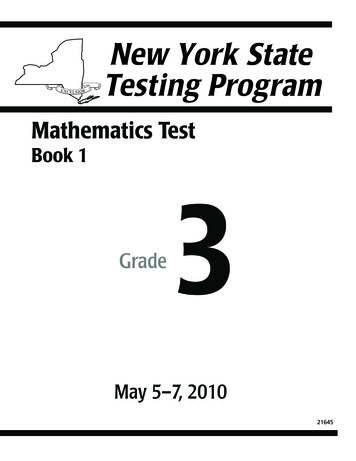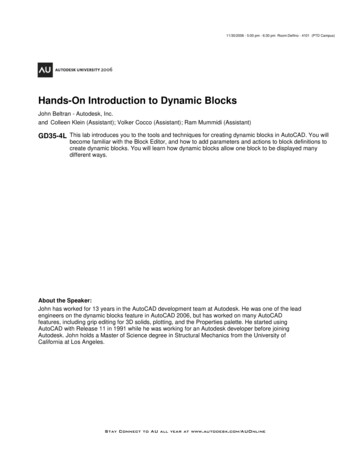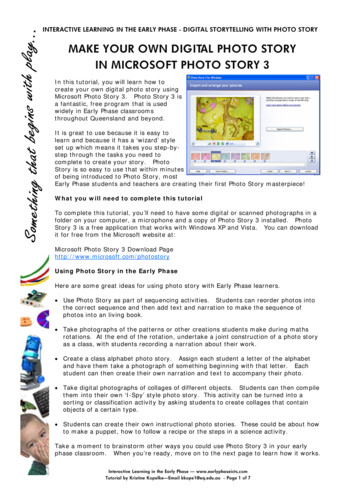
Transcription
Copyright 2007. Taylor & Francis Group. All rights reserved.Block, Bruce. The Visual Story : Creating the Visual Structure of Film, TV and Digital Media, Taylor & Francis Group, 2007. ProQuest Ebook rbondale/detail.action?docID 313789.Created from siucarbondale on 2018-08-19 13:25:21.
olor, without a doubt, is the most misunderstood visual component.Probably due to the misguided color education we received as children, our knowledge of color and how it works is almost unusable.CLightWe use sunlight or artificial lights to illuminate objects so we can see them.Naively, we might say that sunlight is normal “white” light because it doesn’tseem to change the color of objects. A white car parked outside in the sun stilllooks white, so sunlight is not reddish, greenish, or bluish. Sunlight appearsto be normal “white” light.By contrast, the same white car parked in a dark room illuminated with onlyred light appears changed. The car looks red. The red light is not “normal.” Butthe light from the sun is not normal or white, either.Copyright 2007. Taylor & Francis Group. All rights reserved.Take a glass prism and shine a beam of sunlight through it. The prism willrefract the light into a rainbow, or the visible spectrum: red, orange, yellow,green, blue, and violet. The prism experiment shows that sunlight contains allthe colors of the visible spectrum.This time, the prism refracts the light from a 60-watt light bulb. The 60-watt lightbulb also produces the visible spectrum but the proportions of the colors havechanged. The 60-watt bulb contains more red-orange color than the sunlight.136Chapter 6 ColorBlock, Bruce. The Visual Story : Creating the Visual Structure of Film, TV and Digital Media, Taylor & Francis Group, 2007. ProQuest Ebook rbondale/detail.action?docID 313789.Created from siucarbondale on 2018-08-19 13:25:21.Ch06-K80779.indd 1368/9/07 9:00:34 AM
Here are four visible spectrums, each produced by a different light source. Eachspectrum has a different proportion of color. A candle produces a reddish light;a 60-watt household lightbulb has an orange-ish light; stage lights used in colorphotography are less orange, and daylight is predominantly blue. Although noneof these light sources produces white light, the human vision system has theability to adjust for the color variances in different light sources and make themall appear as normal white light. For a detailed explanation of light sources andtheir relationship to film and color temperature, see the appendix.Color SystemsThere are two basic systems for organizing and mixing color: additive and subtractive. Although these two systems share terms and certain characteristics,each must be considered separately.The Additive SystemCopyright 2007. Taylor & Francis Group. All rights reserved.The additive system of color involves the mixing of colored light. Colored lightis mixed by taking a light of one color and a light of another color and beaming them onto a common surface. Where the two colors of light overlap or mix,a third color is produced.The additive system is used most often in theatrical lighting (theatre plays, musicconcerts, circus shows, night clubs, etc.). A red spotlight and a blue spotlight137Block, Bruce. The Visual Story : Creating the Visual Structure of Film, TV and Digital Media, Taylor & Francis Group, 2007. ProQuest Ebook rbondale/detail.action?docID 313789.Created from siucarbondale on 2018-08-19 13:25:21.Ch06-K80779.indd 1378/9/07 9:00:35 AM
are aimed at a performer on a stage, and where the spotlights overlap amagenta color is produced. This is additive color mixing. The red light is addingits wavelengths to the blue light, and a third color, magenta, is the result.Television and computer screens do not mix color using the additive system.See the appendix for an explanation of color mixing on computer and television monitors.The Additive System Color WheelA color wheel organizes colors and shows their relationship to each other. Theadditive system color wheel is shown here.The primary colors in the additive system are red, green, and blue. Combiningtwo primary colors produces the other colors needed to complete the colorwheel. Remember, the additive system is the mixing of light.RED BLUE MAGENTAGREEN BLUE CYANRED GREEN YELLOWCopyright 2007. Taylor & Francis Group. All rights reserved.Magenta is similar to purple, but more reddish. Cyan is like turquoise, butmore greenish.When the additive primaries are mixed together equally, they produce whitelight (or what appears to be white light). Colors opposite one another on thecolor wheel are called complementary colors. The complementary pairs in theadditive system are cyan and red, green and magenta, and blue and yellow.The Subtractive SystemThe subtractive color system is completely separate from the additive system,even though they share terms and certain definitions. The subtractive systemis used in the mixing of pigments, which includes paint and dye. This systemseems more familiar, because everyone has mixed paint in art class or repainteda room. Subtractive mixing is as easy as pouring one color of paint into another.138Chapter 6 ColorBlock, Bruce. The Visual Story : Creating the Visual Structure of Film, TV and Digital Media, Taylor & Francis Group, 2007. ProQuest Ebook rbondale/detail.action?docID 313789.Created from siucarbondale on 2018-08-19 13:25:21.Ch06-K80779.indd 1388/9/07 9:00:35 AM
When red and yellow paint are mixed together the result is orange paint. Thered and yellow paints subtract their wavelengths from each other and create anew color.Almost everything in our real world has been painted, dyed, or pigmentedusing the subtractive system. In photography, lighting and lens filters usethe subtractive system. Colors at a paint store are mixed using the subtractive system. The dyes used for fabrics and rugs; printing inks for magazines,books, and newspapers; paint for walls, cars, appliances; and colors occurringin nature all use the subtractive system.The Subtractive System Color WheelCopyright 2007. Taylor & Francis Group. All rights reserved.The subtractive color wheel looks similar to the additive wheel but the primarycolors are different, as shown here.The primary colors on the subtractive color wheel are magenta, yellow, and cyan.Combining two primary colors produces the other colors needed to completethe color wheel.139Block, Bruce. The Visual Story : Creating the Visual Structure of Film, TV and Digital Media, Taylor & Francis Group, 2007. ProQuest Ebook rbondale/detail.action?docID 313789.Created from siucarbondale on 2018-08-19 13:25:21.Ch06-K80779.indd 1398/9/07 9:00:36 AM
MAGENTA YELLOW REDYELLOW CYAN GREENCYAN MAGENTA BLUEMixing magenta, yellow, and cyan pigments together equally produces black.Colors opposite one another on the subtractive color wheel are called complementary colors. On the subtractive wheel the complementary pairs aremagenta and green, blue and yellow, and red and cyan.Why is basic color theory so misunderstood? The additive and subtractive systems are often mistakenly combined into a single incorrect, confusing system.Most people believe that the primary colors are red, green, yellow, or blue.Many elementary school teachers believe that red, green, blue, and yellow“look” primary, so magenta and cyan colors aren’t even introduced.Another problem with teaching color is that color identification is subjective.People have different ideas in mind when describing a color. It’s impossibleto know exactly what someone means when they say: red, blue, or green. Thevariety of colors people accept as primary covers an unfortunately broad range.Additionally, manufacturing the exact paint to create a true primary color isnearly impossible, and standardization of color names is difficult, so we tendto accept a wide range of colors as primary.Ask anyone in the business of printing pictures in magazines or books andthey’ll tell you that the subtractive primary colors have always been magenta,yellow, and cyan (and black to compensate for inadequacies in the printinginks). Computer ink jet and laser printers also use the subtractive system’s primary colors.Copyright 2007. Taylor & Francis Group. All rights reserved.Colored filters that are used on camera lenses and theatrical lights also usethe subtractive system. These filters are usually colored glass or acetatesheets called gels. Filter colors are mixed subtractively by laying one filterover another. The mixing results are exactly the same as when mixing paint.Overlapping a cyan and a magenta filter creates a blue color. Overlappingmagenta and yellow filters creates red; overlapping cyan and yellow filters creates green. If magenta, yellow, and cyan filters are overlapped together, blackor no light transmission occurs. Each filter has subtracted its wavelength fromthe other two, leaving no light at all. How camera filters can affect the color oflight is explained in the appendix.This is not an instruction book about mixing watercolors, acrylic, or oil paintsfor artists. The theories and systems for mixing artist’s colors vary greatly,depending on the artist’s choice of paint manufacturer and style of working.The purpose of this chapter is to identify, organize, and control color in thephotography of film and video productions.140Chapter 6 ColorBlock, Bruce. The Visual Story : Creating the Visual Structure of Film, TV and Digital Media, Taylor & Francis Group, 2007. ProQuest Ebook rbondale/detail.action?docID 313789.Created from siucarbondale on 2018-08-19 13:25:21.Ch06-K80779.indd 1408/9/07 9:00:36 AM
The Basic Components of ColorTalking about color is difficult because words can never accurately describe acolor. Commercial paint stores use names like “King’s Ransom,” “Liberty,” or“Sorrento” to describe colors in their catalogue. Interior designers use wordslike “mushroom” or “peach,” which may generally describe a color, but stillaren’t very specific. Sometimes colors are given names like “sea-calm” or“romance,” which tell more about the emotion the color hopes to evoke ratherthan a description of the color itself.Ultimately, it’s impossible to accurately describe a color using words. Whatcolor is “candy apple red”?Here are three red colors—any one of them could be “candy apple red.”The only way to describe a specific color is to have an actual sample of thecolor in hand. Commercially available systems, like the Pantone Color Systemand the Munsell Color System, provide color swatches that are accepted worldwide. These systems specify a color based on numbered charts or swatches ofcolor, rather than a verbal description.If color swatches aren’t available, there are three terms that can verballydescribe any color: hue, brightness, and saturation.Copyright 2007. Taylor & Francis Group. All rights reserved.HueThe eight hues are shown here. Hue is the position of a color on the colorwheel: red, orange, yellow, green, cyan, blue, violet (or purple), and magenta.That’s it. There are only eight hues. Pink, brown, turquoise, and beige are nothues. Using the hue name is a good way to begin to describe a color. Stopsigns are red, a lemon is yellow, and grass is green. Although this lacks subtlety, describing exact colors using words is impossible.BrightnessBrightness (sometimes called value) is the addition of white or black to thehue. Brightness is the position of a color in relation to the gray scale.141Block, Bruce. The Visual Story : Creating the Visual Structure of Film, TV and Digital Media, Taylor & Francis Group, 2007. ProQuest Ebook rbondale/detail.action?docID 313789.Created from siucarbondale on 2018-08-19 13:25:21.Ch06-K80779.indd 1418/9/07 9:00:37 AM
Adding white to a red hue creates a bright red (called pink). Adding black to ared hue produces dark red (called maroon or burgundy).At noon, the sky is bright or light blue. At twilight, the sky is dark blue. Wordscan describe color only in a general way.SaturationThe third term used to describe a color is saturation (sometimes called chromaor intensity) and its opposite, desaturation. Saturation refers to the purity of ahue. For example, fully saturated means the hue is extremely vivid. A saturatedred is a red that hasn’t been contaminated by any other hue. It’s 100% red.Desaturation involves a saturated hue and its complementary color. Complementary colors are opposite one another on the color wheel.Copyright 2007. Taylor & Francis Group. All rights reserved.As an example, begin with the hue of red. Like all the colors on the wheel,this red is the purest, most vivid, saturated color possible. If a small amountof cyan (red’s complementary color) is added to the red hue, the red beginsto change. It begins to turn gray. This is called desaturation. The more cyanthat is added, the grayer the red will become. When equal amounts of cyanand red are mixed together, there will be no trace of either hue; only gray willremain. Any color will desaturate (or turn gray) by adding its complementarycolor. When a hue is extremely pure or vivid, it is saturated. The grayer thecolor becomes the more desaturated it appears.142Chapter 6 ColorBlock, Bruce. The Visual Story : Creating the Visual Structure of Film, TV and Digital Media, Taylor & Francis Group, 2007. ProQuest Ebook rbondale/detail.action?docID 313789.Created from siucarbondale on 2018-08-19 13:25:21.Ch06-K80779.indd 1428/9/07 9:00:37 AM
Here are the subtractive complementary pairs. As complementary colors are mixedtogether, they desaturate their partner and when mixed equally, create gray.Hue, brightness, and saturation are the only terms needed to describe a color.These three terms are not exact, but using them is better than words found ondesigner brand paints like “sea-calm” or “liberty.” To precisely describe a color,you must show a sample of it, but a color can be generally described usinghue, brightness, and saturation.There are a few other terms frequently used to describe a color. Tint andpastel mean adding white to a hue. Shade usually means adding the complementary color, but sometimes it means adding black. To avoid confusion, don’tuse these terms at all.Look around you and try to describe the color of objects in terms of hue,brightness, and saturation. Most objects contain color, even if they appeargray. They’re just partially desaturated.Copyright 2007. Taylor & Francis Group. All rights reserved.This diagram illustrates a range of colors that were created by adding black,white, or cyan to a fully saturated red. The red rectangle on the right is the mostsaturated. The colors desaturate as they move to the left, become brighter asthey move up, and darker as they move down the diagram. Any one of the colors can be generally described in terms of hue, brightness, and saturation.This diagram can be made for each of the six basic colors on the color wheel.143Block, Bruce. The Visual Story : Creating the Visual Structure of Film, TV and Digital Media, Taylor & Francis Group, 2007. ProQuest Ebook rbondale/detail.action?docID 313789.Created from siucarbondale on 2018-08-19 13:25:21.Ch06-K80779.indd 1438/9/07 9:00:38 AM
Brightness versus SaturationA basic color wheel always displays the hues in their fully saturated (mostpure or vivid) state. But the brightness of these saturated hues is different. Ablack and white photograph of the subtractive wheel reveals the wide brightness range inherent in fully saturated colors.Here’s a color wheel, and beside it, the same wheel reproduced in black andwhite. Yellow is the brightest saturated color. Orange is almost as bright.A saturated red, green, and cyan appear as middle gray. Blue and violet are thedarkest saturated colors.Copyright 2007. Taylor & Francis Group. All rights reserved.Knowing the inherent brightness levels of different saturated hues is important. A saturated yellow will always attract the viewer’s eye first, not onlybecause it’s saturated, but also because it’s very bright. A saturated blue willalways appear much darker than a saturated yellow. By adding white, thebrightness level of the blue can be raised to match the yellow, but the bluewon’t retain its saturation because it’s too bright. It is impossible to create abasic color wheel where all the hues are simultaneously of equal brightnessand equal saturation.These hues are of equal saturation, but vary in brightness.These hues vary in saturation, but are of equal brightness.144Chapter 6 ColorBlock, Bruce. The Visual Story : Creating the Visual Structure of Film, TV and Digital Media, Taylor & Francis Group, 2007. ProQuest Ebook rbondale/detail.action?docID 313789.Created from siucarbondale on 2018-08-19 13:25:21.Ch06-K80779.indd 1448/9/07 9:00:39 AM
Contrast and AffinityThere are many ways to produce contrast or affinity of color. Remembercontrast and affinity can occur within the shot, from shot to shot, and fromsequence to sequence.HueContrast of hue occurs when the major color differences in a shot are dueto hue.Copyright 2007. Taylor & Francis Group. All rights reserved.The color differences in this picture are due to changes in hue.Affinity of hue occurs when all colors in the picture are based on a singlehue. Every color in the shot is green even though the brightness and saturationcan vary.145Block, Bruce. The Visual Story : Creating the Visual Structure of Film, TV and Digital Media, Taylor & Francis Group, 2007. ProQuest Ebook rbondale/detail.action?docID 313789.Created from siucarbondale on 2018-08-19 13:25:21.Ch06-K80779.indd 1458/9/07 9:00:40 AM
Bergman’s Cries and Whispers color scheme is based on a lightened, darkened,saturated, or desaturated red. Contrast and affinity of hue can occur within ashot, from shot to shot, and from sequence to sequence.BrightnessCopyright 2007. Taylor & Francis Group. All rights reserved.Brightness refers to the tonal range of the colors in the shot. A scene that usesonly very bright and very dark colors illustrates contrast of brightness. A scenethat uses only bright colors will show affinity of brightness.Here are illustrations of affinity (all dark red) and contrast (bright and darkblue) of brightness within the shot. Contrast and affinity of brightness canoccur within a shot, from shot to shot, and from sequence to sequence.SaturationA picture using only saturated colors illustrates affinity of saturation. A pictureusing saturated and desaturated colors illustrates contrast of saturation.146Chapter 6 ColorBlock, Bruce. The Visual Story : Creating the Visual Structure of Film, TV and Digital Media, Taylor & Francis Group, 2007. ProQuest Ebook rbondale/detail.action?docID 313789.Created from siucarbondale on 2018-08-19 13:25:21.Ch06-K80779.indd 1468/9/07 9:00:45 AM
These examples show contrast or affinity of saturation. The first example iscontrast; all the color in the shot has been desaturated, except for the fullysaturated red jacket. In the second example, all the colors are grayed-out,creating affinity of desaturation.Contrast and affinity of saturation can occur within a shot, from shot to shot,and from sequence to sequence.Copyright 2007. Taylor & Francis Group. All rights reserved.Warm/CoolA color wheel can be used to generally classify the warm and cool hues. The warmhues are red-magenta, red, orange, and yellow. The cool hues are blue-magenta,blue, green, cyan, and yellow-green.147Block, Bruce. The Visual Story : Creating the Visual Structure of Film, TV and Digital Media, Taylor & Francis Group, 2007. ProQuest Ebook rbondale/detail.action?docID 313789.Created from siucarbondale on 2018-08-19 13:25:21.Ch06-K80779.indd 1478/9/07 9:00:49 AM
In terms of visual perception, magenta appears to be a combination of a warmhue (red) and a cool hue (blue), so depending on the proportion of red or blue,magenta can appear warm or cool. Yellow is a warm hue, but when mixed witha small amount of green, it appears to lose its warmth and becomes cool.Hues can be combined in an infinite number of ways to produce warm andcool colors. Mixing complementary hues can change the warmth or coolnessof any color.Here are examples of warm and cool affinity within a shot. Contrast and affinity of warm/cool can occur within a shot, from shot to shot, or from sequenceto sequence.ExtensionColor extension deals with a color’s brightness and physical proportion in relation to other colors.Copyright 2007. Taylor & Francis Group. All rights reserved.The saturated hues are shown in color and gray tones that correspond to theactual brightness of the saturated color above it. Yellow is the brightest saturated color and blue/magenta, the darkest.148Chapter 6 ColorBlock, Bruce. The Visual Story : Creating the Visual Structure of Film, TV and Digital Media, Taylor & Francis Group, 2007. ProQuest Ebook rbondale/detail.action?docID 313789.Created from siucarbondale on 2018-08-19 13:25:21.Ch06-K80779.indd 1488/9/07 9:00:54 AM
Here is a picture in color, and then the same picture in black and white. Noticehow the tonal range is revealed.Don’t confuse tone with color. A saturated color might look intense, but theaudience’s attention will probably be drawn to brightness first. A saturated yellow will always attract an audience’s attention, because it is not only saturated,but also extremely bright. A saturated magenta, because it is so dark, will tendto be ignored. As any color darkens, its ability to attract the eye decreases.Interaction of ColorIn his famous color studies at Yale University, the artist Josef Albers demonstrated and defined what has come to be called color interaction.Albers’ studies clarified theories about how colors appear to change their hue,brightness, or saturation when placed next to each other. His demonstrations,based on his personal work and the work of his students, developed into a setof rules that accurately predict how colors will interact.Making a color change its appearance requires two ingredients: The susceptible color—This is the color that will appear to change. The neighbor—This is the color or tone that will activate the change in thesusceptible color.Here are three basic rules of color interaction.Hue and Black or WhiteCopyright 2007. Taylor & Francis Group. All rights reserved.Color interaction occurs when black or white is placed next to a color, but theresults vary depending on the proportions.This example uses cyan as the susceptible color and black or white asthe neighbor. When cyan is surrounded by white, the cyan looks darker.Surrounding the same cyan with black makes the cyan look lighter.The susceptible color shifts in opposition to the brightness of the neighboringtone. As the proportion of the neighboring white or black increases, the susceptible hue’s tone appears to shift farther away from the background tone.If the proportions and distribution of the black or white changes in relation tothe susceptible hue, the opposite result occurs. This phenomenon, known as149Block, Bruce. The Visual Story : Creating the Visual Structure of Film, TV and Digital Media, Taylor & Francis Group, 2007. ProQuest Ebook rbondale/detail.action?docID 313789.Created from siucarbondale on 2018-08-19 13:25:21.Ch06-K80779.indd 1498/9/07 9:01:04 AM
the Bezold Effect, has no satisfactory explanation as it completely contradicts theusual combination of black, white, and a susceptible hue. Sometimes calledthe spreading effect, the same color appears brighter when placed around whiteand darker when placed around black. The susceptible color adopts the brightness of the neighboring tone.This figure shows the Bezold Effect.These kinds of color interactions are called simultaneous contrast becausethey occur within a single picture or shot.Complementary ColorsThe second type of color interaction involves complementary colors.Complementary colors are opposite one another on the color wheel. Whencomplementary colors are placed next to one another, their saturationincreases. In this example, both red and cyan are susceptible.Copyright 2007. Taylor & Francis Group. All rights reserved.A red and cyan of equal proportion are placed side by side. These complementarycolors will appear more saturated than if they were placed next to other colors.As the proportion of the complementary colors changes, the larger color becomesless susceptible, and the smaller color becomes more susceptible. The redchanges from a susceptible color to a neighboring color. The largest area of redis unchanged by the tiny cyan square. However, the tiny square of cyan dramatically increases in saturation, due to the large surrounding area of red.150Chapter 6 ColorBlock, Bruce. The Visual Story : Creating the Visual Structure of Film, TV and Digital Media, Taylor & Francis Group, 2007. ProQuest Ebook rbondale/detail.action?docID 313789.Created from siucarbondale on 2018-08-19 13:25:21.Ch06-K80779.indd 1508/9/07 9:01:05 AM
An orange swatch is placed on a blue background and on a yellow background.Even though the two orange swatches are identical, the orange on the bluebackground appears more saturated than the orange on the yellow background. This is called simultaneous contrast, because both susceptible orangecolors are in the picture at the same time.The same interaction can be created from shot to shot, which is called successive contrast. Now the viewer will look at one picture, and then at a secondpicture. This happens when an editor cuts from one shot to another. In successive contrast, only the second color is susceptible to change.If a viewer is shown a primarily red scene and then a primarily cyan scene, thecyan becomes susceptible, and will appear far more saturated due to the colorinteraction of successive contrast.Analogous ColorsCopyright 2007. Taylor & Francis Group. All rights reserved.Analogous colors are neighbors on the color wheel. The third rule of colorinteraction states that when analogous colors are placed next to one another,they appear to push apart, or separate, in their position on the color wheel.For example, red and orange are analogous colors.151Block, Bruce. The Visual Story : Creating the Visual Structure of Film, TV and Digital Media, Taylor & Francis Group, 2007. ProQuest Ebook rbondale/detail.action?docID 313789.Created from siucarbondale on 2018-08-19 13:25:21.Ch06-K80779.indd 1518/9/07 9:01:06 AM
In this illustration, orange is the susceptible color. An orange swatch on a redbackground will appear yellower. The same orange swatch on a yellow background will appear redder.A color wheel can diagram this interaction. The red background pushes theorange toward the yellow. The yellow background pushes the orange towardthe red.How can color interaction be used in practical production? Suppose an actionsequence requires red flames and, for dramatic effect, they should appear assaturated red as possible. Using interaction of color, it’s possible to create asituation on screen that will help the flames appear more saturated. The solution involves simultaneous and successive contrast.Copyright 2007. Taylor & Francis Group. All rights reserved.If a cyan background is placed behind the red flames, the flames will appearmore saturated, because complementary colors increase saturation. This issimultaneous contrast (contrast within the shot). The red flames will appearmore saturated because the viewer is simultaneously looking at complementary colors.Another solution involves preceding the fire scene with a sequence of primarily cyan shots. This is successive contrast because the cyan color is seen firstand the complementary red color follows (just like contrast from shot to shot).If the audience watches the cyan for approximately 15 seconds, and then seesthe complementary red color, the red flames will appear far more saturated.The exact physiological reasons why successive and simultaneous contrastworks are not completely understood. However, a simple experiment can demonstrate the basic phenomenon.152Chapter 6 ColorBlock, Bruce. The Visual Story : Creating the Visual Structure of Film, TV and Digital Media, Taylor & Francis Group, 2007. ProQuest Ebook rbondale/detail.action?docID 313789.Created from siucarbondale on 2018-08-19 13:25:21.Ch06-K80779.indd 1528/9/07 9:01:07 AM
Copyright 2007. Taylor & Francis Group. All rights reserved.Position this book about 12 inches from your eyes in a strong light source. Getcomfortable. Stare at the dot in the cyan circle for a full minute, and then shiftyour eyes to the dot in the white circle. You should see a red colored circleappear briefly in the white circle.153Block, Bruce. The Visual Story : Creating the Visual Structure of Film, TV and Digital Media, Taylor & Francis Group, 2007. ProQuest Ebook rbondale/detail.action?docID 313789.Created from siucarbondale on 2018-08-19 13:25:21.Ch06-K80779.indd 1538/9/07 9:01:07 AM
The red colored circle you saw is called an afterimage. The afterimage appearsfor a number of reasons. The eye will always produce
Block, Bruce. The Visual Story : Creating the Visual Structure of Film, TV and Digital Media, Taylor & Francis Group, 2007. ProQuest Ebook Central, Color .










